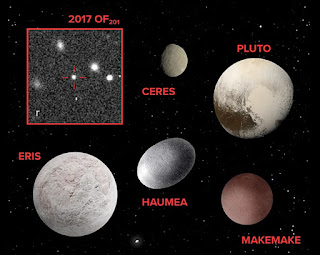 |
| Image Credit: images of dwarf planets from NASA/JPL-Caltech; image of 2017 OF201 from Sihao Cheng et al. |
Have you ever wondered how many worlds still lurk, unseen, at the dark edge of our Solar System? Welcome, curious minds! We at FreeAstroScience.com just dove into two brand-new research papers—and we’re buzzing with excitement. Join us on a quick but thrilling journey to 90 astronomical units (AU) from the Sun to meet 2017 OF201, a 700-kilometer ice ball that may earn the title of “dwarf planet” and might even topple the famous Planet 9 hypothesis. Buckle up and read to the end; you’ll never look at the outer Solar System the same way again.
What exactly is 2017 OF201, and why did we miss it for so long?
1. A needle in a cosmic haystack
- Orbit: Stretches from 45 AU at perihelion to a staggering 1,600 AU at aphelion.
- Period: ~25,000 years—ten times longer than recorded human history!
- Visibility: Detectable for barely 0.5 % of its orbit. No wonder it stayed hidden.
2. Found in old pictures
Researchers Sihao Cheng and Jiaxuan Li combed through archival images from DECaLS and CFHT. Ten faint specks, spread over seven years, lined up into one unmistakable orbit. Anyone with public data and smart code could have done it—citizen science at its finest!
3. Size does matter
Using a typical icy-body albedo (0.15), they estimate a diameter of ~700 km—one-third Pluto’s width and large enough to round itself into a sphere. Translation: it almost certainly qualifies as a dwarf planet.
How does this discovery rewrite our map of the outer Solar System?
H2
1. A new population hiding in the dark
Seeing one object during its tiny visibility window hints at hundreds more on similar paths. Their combined mass could rival 1 % of Earth—about the weight of our Moon—quietly orbiting far beyond Neptune.
2. Inner Oort Cloud crossover
With its huge semi-major axis (838 AU), 2017 OF201 sits on the blurry border between the scattering disk and the inner Oort Cloud. Simulations show Neptune may have kicked it outward first; then the slow tug of the Milky Way’s tides lifted its perihelion. A two-step dance spanning billions of years.
3. Trouble for Planet 9
Many extreme TNOs (Sedna, 2012 VP113, etc.) cluster around the same longitude of perihelion—one argument for a hidden Planet 9 shepherding them. But our newcomer’s perihelion points the wrong way (ϖ ≈ 306° vs. 60°). In models that include Planet 9, 2017 OF201 gets ejected within 100 million years. Its mere existence, therefore, pokes a sizeable hole in the prevailing Planet 9 narrative.
Why should you care about one distant ice rock?
H2
1. Proof our backyard still surprises us
Thirty years after the first Kuiper Belt discoveries, we’re still uncovering planetary-scale bodies with laptops and public data. What else awaits?
2. Citizen-science empowerment
Because DECaLS images are public, you could help spot the next dwarf planet. All it takes is code, patience, and a love for the unknown.
3. Refining Solar-System formation models
Each new extreme TNO tightens constraints on giant-planet migration, galactic-tide strength, and even rogue-star flybys. 2017 OF201 offers a fresh calibration point.
| Parameter | Value | Significance |
|---|---|---|
| Semi-major axis (a) | 838 AU | Places 2017 OF201 in the inner Oort Cloud region |
| Perihelion (q) | 44.9 AU | Located just beyond Neptune, currently within observational reach |
| Estimated Diameter | ~700 km | Large enough to be nearly spherical; likely meets dwarf planet criteria |
| Orbital Period | ~25,000 years | Reveals deep-time Solar System dynamics |
| Longitude of Perihelion (ϖ) | 306° | Differs from Planet 9 clustering, challenging existing models |
Conclusion: A tiny world with giant implications
2017 OF201 reminds us that the Solar System is far from catalogued. Its odd orbit challenges the Planet 9 idea, hints at a hefty unseen population, and showcases the power of data mining. Keep your telescopes—and algorithms—ready: the next cosmic secret may be sitting in a dusty hard drive right now.
Stay curious, and clear skies!
Written with passion by the Free AstroScience team—where we turn cosmic complexity into everyday wonder.
A paper describing the discovery is available at arXiv.

Post a Comment